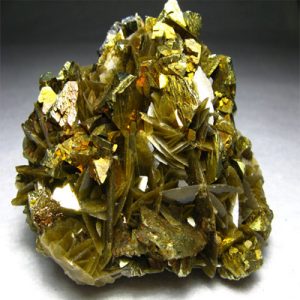Chalcopyrite
Chalcopyrite is a fairly common mineral that is often confused with Pyrite (FeS2). Chalcopyrite typically has a brass-yellow colour and I be tarnished and iridescent. “Peacock Ore” which is sold to many amateur mineral collectors often as a variety of Bornite, is in fact almost always Chalcopyrite treated with acid to produce an iridescent tarnish. Though some Chalcopyrite is naturally iridescent, wild colours such as strong blues and purples are usually formed from acid treatment.It is one of the minerals sometimes referred to as “Fool’s Gold” because of its bright golden colour. Its widespread distribution and large quantities make Chalcopyrite a major ore of copper even though its yield of only 25% is rather low compared to other copper minerals such as Chalcocite (67%); Cuprite (67%); Bornite (50%); and Covellite (50%).
Chalcopyrite is found in many localities worldwide. Notable occurrences include Rouyn district, Quebec, Canada; Huaron, Peru; the Nababiep Mine, Cape Province, South Africa; and Bisbee, Cochise County, Arizona, USA.
| Category: | Sulfide mineral |
| Chemical Formula: | CuFeS2 |
| Copper Iron Sulfide | |
| Molecular Weight: | 521.21 gm |
| Composition: | Iron | 30.43 % | Fe | ||
| Copper | 34.63 % | Cu | |||
| Sulfur | 34.94 % | S | |||
| 100.00 % |
| Crystallography: | Tetragonal – Scalenohedral |
| Crystal Habit: | Equant, tetrahedral-shaped crystals, may be modified by scalenohedral faces, to as large as 10 cm. Sphenoidal faces typically large, dull in lustre and striated. Commonly massive, compact; can be botryoidal. |
| Twinning: | Twin plane {112}, composition surface commonly {112}; twin plane {012}; also by rotation about {001} with composition plane {110}, producing penetration twins. |
| Cleavage: | Poor/Indistinct on {011}, Poor/Indistinct on {111} |
| Fracture: | Irregular/Uneven |
| Tenacity: | Brittle |
| Moh’s Hardness: | 3.5 – 4.0 |
| Density: | 4.1 – 4.3 (g/cm3) |
| Luminescence: | None |
| Radioactivity: | Not Radioactive |
| Other: | Magnetic after heating. |
| Color: | Brass Yellow, honey Yellow; may be tarnished and iridescent |
| Transparency: | Opaque |
| Luster: | Metallic |
| Refractive Index: | R1–R2: (400) 16.0–17.3, (420) 20.0–21.3, (440) 24.8–26.1, (460) 30.2–31.4, (480) 34.9–35.9, (500) 38.9–39.9, (520) 41.9–42.7, (540) 44.0–44.9, (560) 45.4–46.4, (580) 46.6–47.6, (600) 47.1–48.3, (620) 47.5–4.86, (640) 47.6–48.7, (660) 47.6–48.7, (680) 47.6–48.6, (700) 47.6–48.6 |
| Birefringence: | None; Opaque |
| Dispersion: | None |
| Pleochroism: | None |
| Anisotrophism: | Weak |


